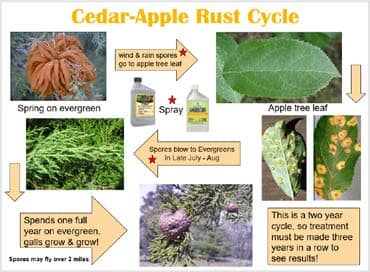Cedar Apple Rust

Apple, Hawthorn and Quince Rust are closely related rust diseases that require two hosts to complete their life cycle.
All three rusts can infect most varieties of Eastern Red Cedar as well as many other junipers.

Cedar-apple rust infects mostly apple and crabapple. Cedarhawthorn rust infects those, as well as quince, serviceberry, pear and hawthorn. Cedar-quince rust infects all of those plus mountain-ash, cotoneaster, chokeberry and quince.
Spores start out as galls on cedars. These galls show up about 7 months after infection. After about 18 months, in the rainy season, the galls will swell and form a gelatinous, orange-brown mass.
This is when the spores are released and blown to the leaves of the plant to be infected. These spores can not infect the cedar, only other plants.

Once on the infected plant, the spores create lesions on the leaf surface, these will have the rusty look. As the fungus progresses, on the under side of the leaves, raised structures develop. From these structures, the spores that will blow over to infect the cedars will come. This will occur in the late summer.
Control
Spray applications need to be applied before and during the time when the spores are present.
In the spring, watch the galls on the cedar trees and when you see the gelatinous masses enlarging, begin spraying every 7 to 10 days on the trees you want to protect, not cedars. On cedars the applications need to be made every 10 to 14 days, late July through August.
On edible plants use FL F-Stop or NG Copper Soap, once the gelatinous masses begin drying up you may stop applying.
On non-edibles and cedars use FL Liquid Systemic Fungicide. Increase absorption and effectiveness of the fungicides with the addition of HY Spreader Sticker.


